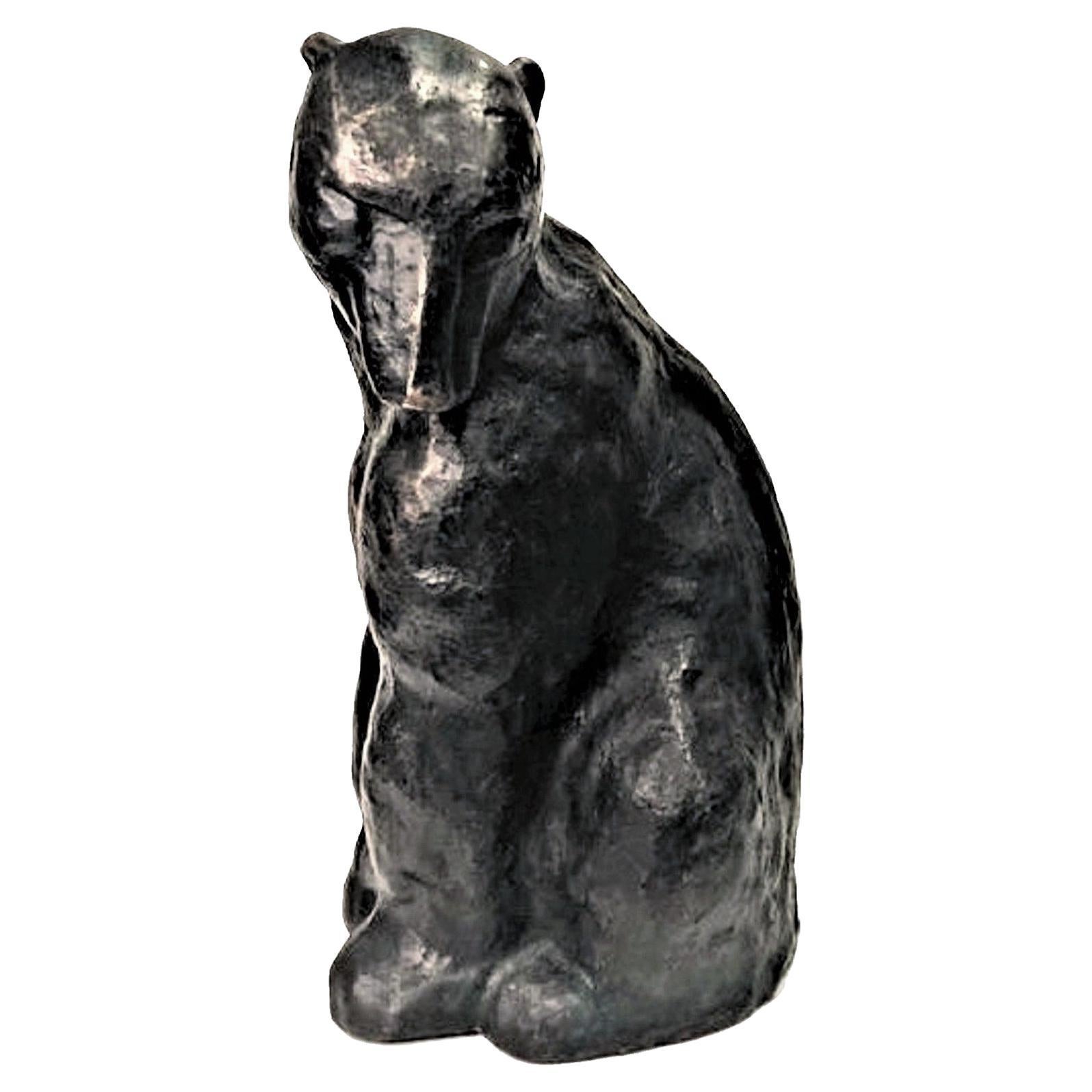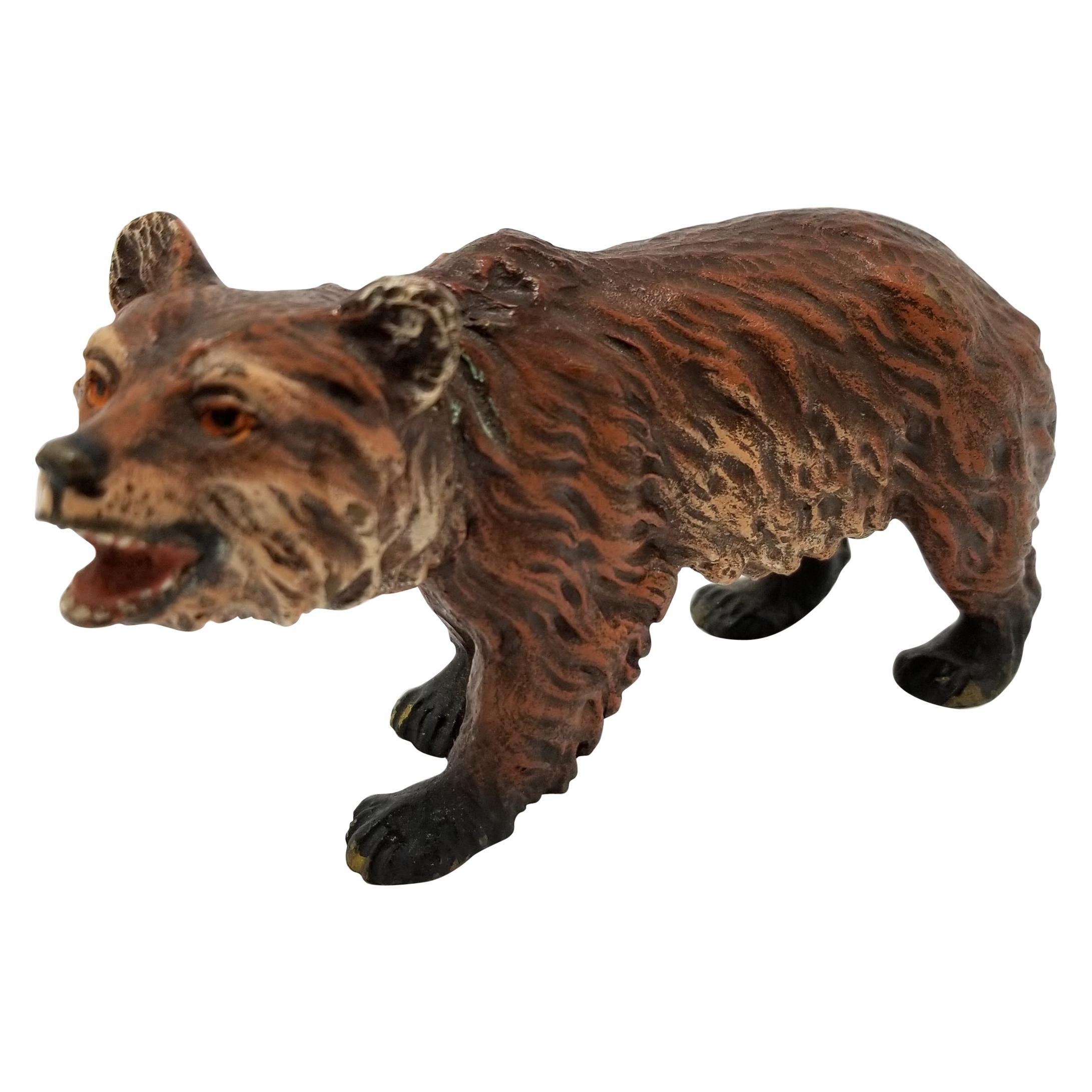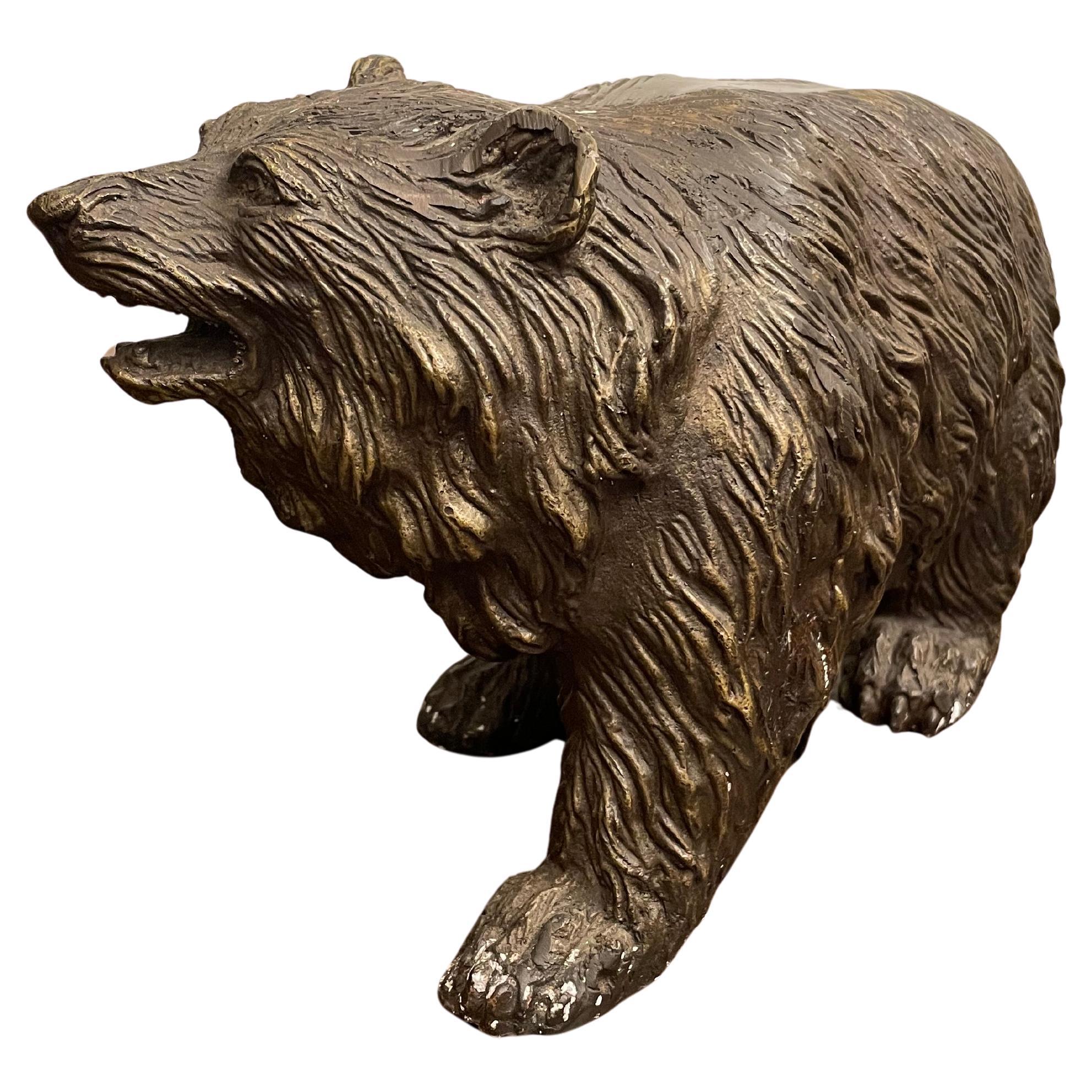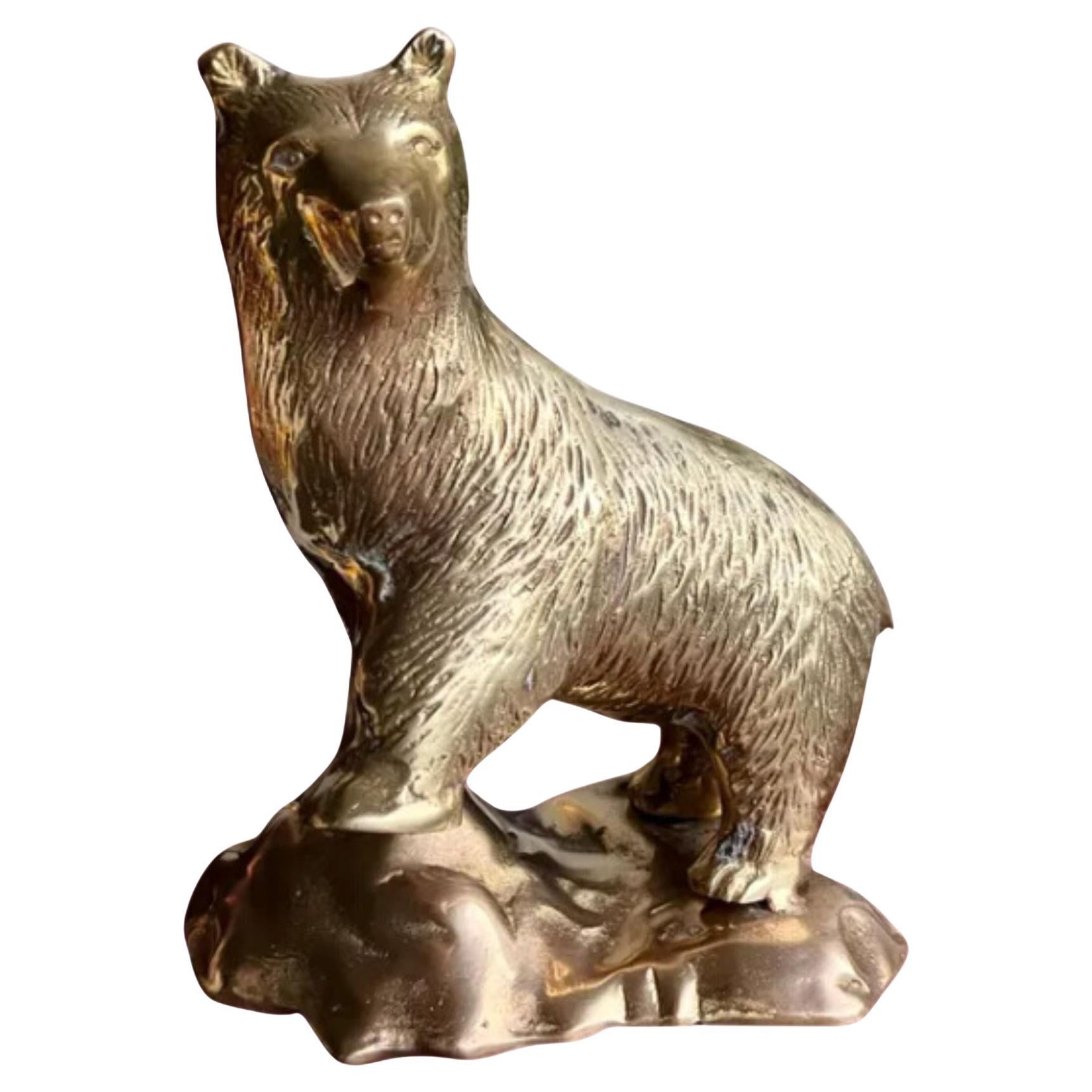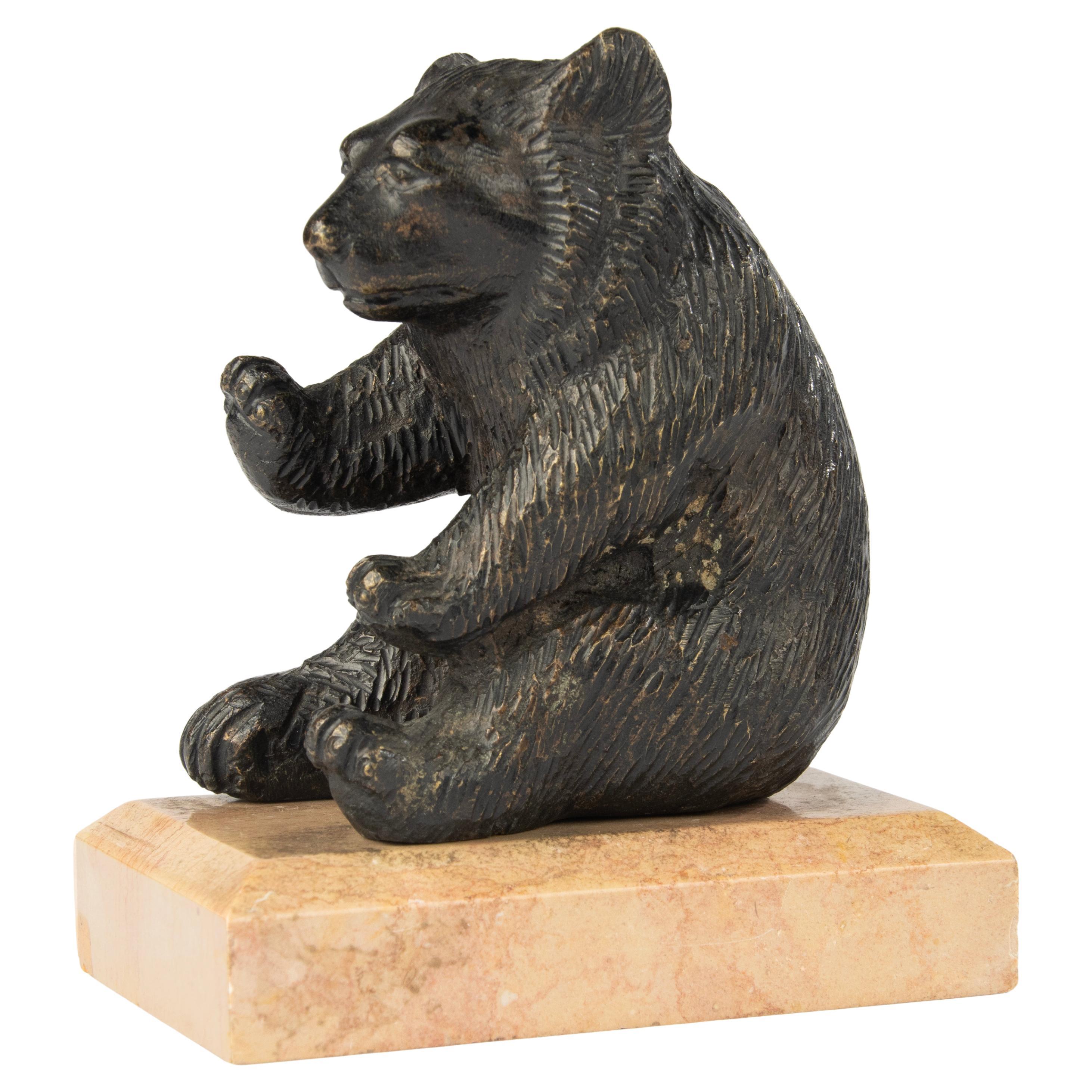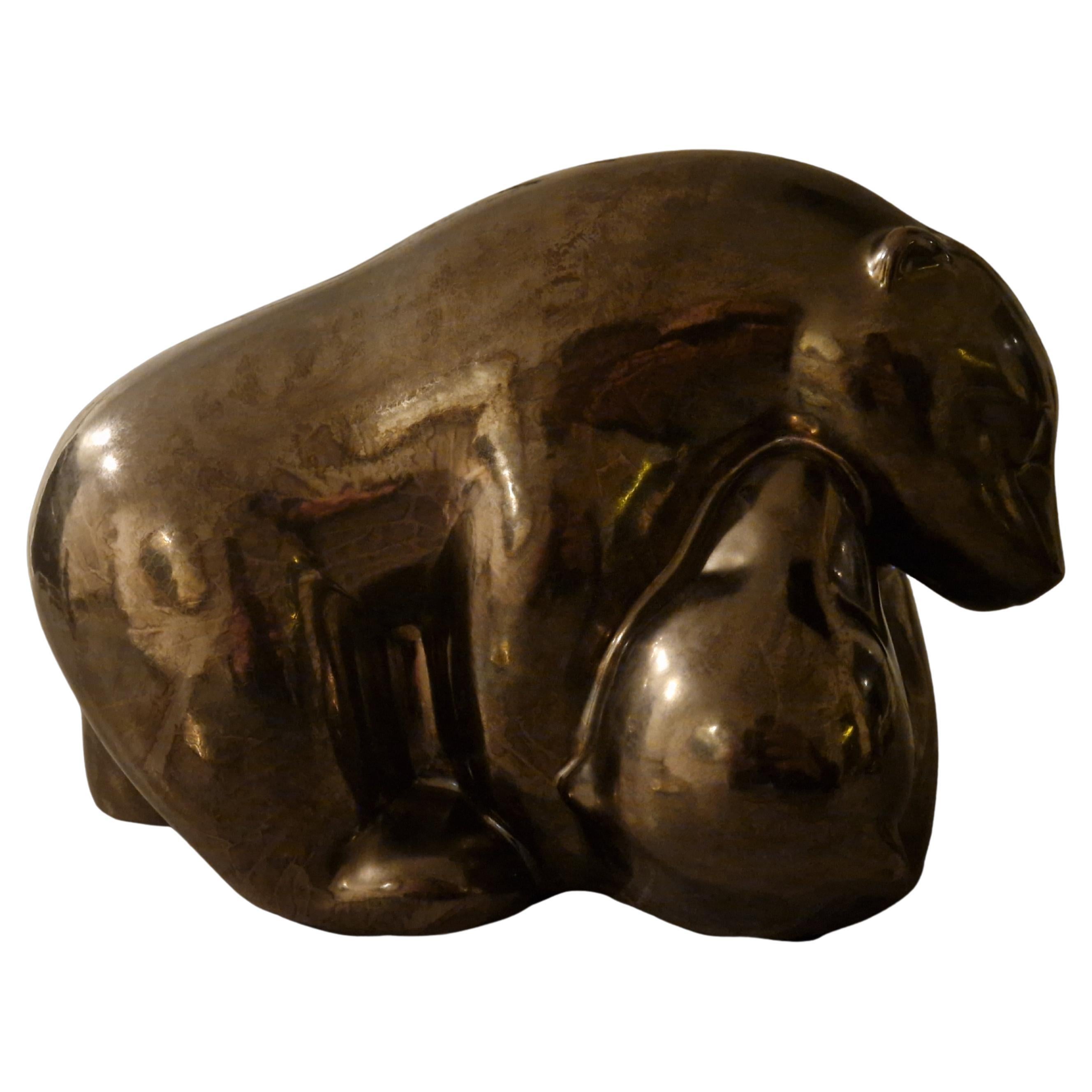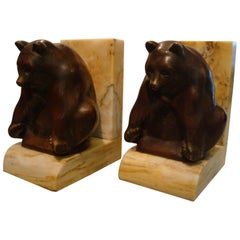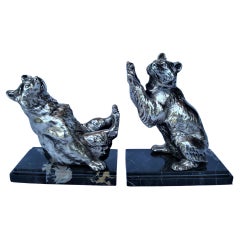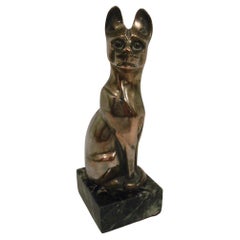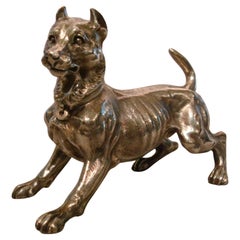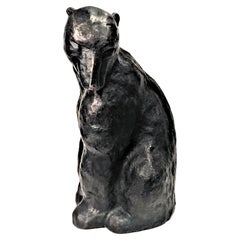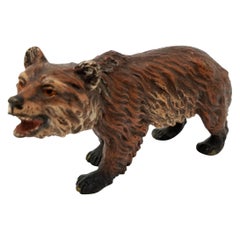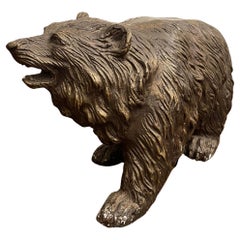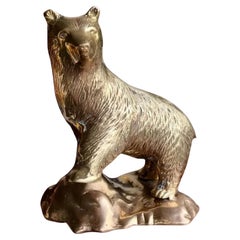Items Similar to Young Bear Bronze Figure / Sculpture. 1920´s Car Mascot / Hood Ornament
Want more images or videos?
Request additional images or videos from the seller
1 of 10
Young Bear Bronze Figure / Sculpture. 1920´s Car Mascot / Hood Ornament
$1,200
£906.13
€1,044.22
CA$1,693.71
A$1,867.28
CHF 976.90
MX$22,908.02
NOK 12,297.22
SEK 11,499.85
DKK 7,798.23
About the Item
Young bear bronze figure / Sculpture. Probably paperweight or car mascot - hood ornament. Very nice details. Very good foundry quality, with original brown patina.
We have specialized in the sale of Art Deco and Art Nouveau and Vintage styles since 1995. If you have any questions we are at your disposal. Pushing the button that reads 'View All From Seller'. And you can see more objects to the style for sale. Why are there so many antiques in Argentina?
In the 1880 – 1940 there was a grate wave of immigration encouraged by the periods of war that were taking place. 1st World War took place between 1914 and 1918 2nd World War took place between 1939 and 1945 The immigrants options were New York or Buenos Aires. Tickets were cheap and in Buenos Aires they were welcomed with open arms, as it was a country where everything was still to be done. Argentina was the country of new opportunities, labour was needed and religious freedom was assured, in many cases the of the family travel first until they were settled and then the rest of the family members join them. In the immigrant museum “Ellis Island Immigrant Building” in New York you can se the promotional posters of the boats that would take them to a new life. Between the years 1895 and 1896, Argentina had the highest DGP (gross domestic product) per capita in the world according to the Maddison Historical Statistics index, this situation arose due to the large amount of food being exported to European countries, which were at war. The Argentinean ships left the port of Buenos Aires with food, but they returned with furniture, clothes and construction elements, (it´s common to see this the old buildings of the historic neighbourhood of San Telmo, the beams with the inscription “Made in England)”, as well as many markets that were built in Buenos Aires, such us the San Telmo Market, whose structure was brought by ship and afterwards assembled in 900 Defensa Street. With the great influence of European immigrants living in the country, the children of the upper classes travelled to study in France, resulting in the inauguration of “La Maison Argentinienne”, on 27th of June 1928, in the international city of Paris, which hosted many Argentinians that were studying in Frace. It´s the fourth house to be built after France, Canada and Belgium, being the first Spanish-speaking one. Still in place today (17 Bd Jourdan, 75014, Paris, France). Many of the children of these wealthy families who attended international art exhibitions, museums and art courses abroad, took a keen interest in the European style. This is why Buenos Aires was at the time referred as “The Paris of South America”. Between the years 1890 and 1920 more than a hundred Palaces were built on Alvear Avenue the most exclusive avenue in Buenos Aires. Today some of these palaces have been transformed into museums, hotels and embassies. In the year 1936, the Kavanagh building was inaugurated, it was the tallest reinforced concrete building in South America. During 1994 the American Society of Civil Engineers distinguished it as an “international engineering milestone”, and it´s now considered a World Heritage of Modern Architecture. At the time was common to hire foreign architects such as Le Corbusier, who visited Buenos Aires/Argentina in 1929 and in 1948 he drew up the blueprints for a house built in La Plata City (which was declared a World Heritage Site). In 1947, the Hungarian architect Marcelo Breuer designed “Parador Ariston” in the seaside city of Mar del Plata. After an Argentinean student at Harvard University convinced him to come to Argentina. He worked on an urban development project in the Casa Amarilla, area of La Boca. The Ukrainian architect, Vladimiro Acosta, arrives in Argentina in 1928 and worked as an architect until que moved to Brazil. Antonio Bonet, a Spanish architect who worked with Le Corbusier in Paris, arrives in Argentina in 1937, where he carried out several architectural works and in 1938 designs the well-known BFK chair. Andres Kálnay, of Hungarian origin, made around 120 architectural masterpieces, among which the former Munich brewery stands out, he even made the furniture’s design. The German architect, Walter Gropius, director of the Bauhaus, lived in Argentina, where he wrote articles for “Sur” magazine and founded in Buenos Aires, an architectural firm with Franz Möller, who was also an architect, where he built two houses. At the same time several famous designers decided to immigrate to Argentina, among them we can find the well-known French designer, Jean-Michel Frank, who arrived in the country in 1940 and also worked for the Rockefeller family. Special pieces were made, which were sold exclusively in the country, such as the well-known German company “WMF”, who sold their products by catalogue, which were chosen by the ladies of high society in the list of wedding gifts, as well as the pieces designed by Christofle. The Swiss sculptor Alberto Giacometti, made special pieces for Argentinean mansions. In 1904 the first Jansen branch outside Paris was established in Buenos Aires, as the Argentinean clientele demanded a large amount of furniture, from the end of the 19th century to the mid-20th century. In 1970, the brand Rigolleau Argentina made pieces authorised by Lalique. The brands Maple and Thompson also set up shop in the country. The French plastic artist, Marcel Duchamp moved to Argentina in 1918-1919. Glass signed Gallé, Charder, Leverre, Schneider, Muller and other French firms. They were bought in flower shops and were given to ladies with beautiful floral arrangements. Some furniture manufacturers travelled to international fairs and bough the patterns to produce the furniture in Argentina, such as the furniture firm Englander and Bonta, who bought the patterns in Italy. It is worth mentioning that in Argentina we have the largest community of Italians outside of Italy, as it is estimated that 70 percent of the inhabitants have at least one Italian descendant, followed by Spanish immigrants. The most Important furniture stores in Argentina: Comte is founded in 1934 (under the direct management of Jean Michel Frank in 1940). Nordiska (Swedish company established in 1934). Churba in 1960, a company that brought foreign designers to present their furniture in the country: Denmark: (Arne Jacobsen, Finn Juhl, Bender Madsen, Ejner Larsen, Poul Kjaerholm, Hans Wegner) Sweden: (Hans Agne Jakobsson, Gustavsberg) United States: (Herman Miller) Finland: (Lisa Johansson, Folke Arstrom, Tapio Wirkkala, Alvar Aalto, Timo Sarpaneva) Swedish Factory: (Orrefors) Italy: (Littala, Vico Magistretti, Emma Gismondi, Gae Aulenti, Angelo Mangiarotti, Elio Martinelli, Gianna Celada, Angelo Mangiarotti, Mario Bellini, Carlo Scarpa) Finland: (Olivia Toikka) Plata Lappas (Lappas Silver): a goldsmith shop founded in 1887 in Argentina by Alcibiades Lappas of Greek origin. In 2019, in Argentina took place “the Art Deco world congress” . Argentina currently has more than 100 Art Deco buildings and another 90 Art Nouveau buildings throughout the city of Buenos Aires. Argentina is a country that has not been involved in many wars, which is why it has been a refuge for works of art and antiques from different periods of time, unlike European countries. That is way many collectors, museums and antique dealers from all over the world visit it, you should not miss the opportunity to visit this great country.
- Dimensions:Height: 7.09 in (18 cm)Diameter: 3.94 in (10 cm)
- Style:Art Deco (Of the Period)
- Materials and Techniques:Bronze,Patinated
- Place of Origin:
- Period:
- Date of Manufacture:1920s
- Condition:Wear consistent with age and use.
- Seller Location:Buenos Aires, AR
- Reference Number:1stDibs: LU202736749013
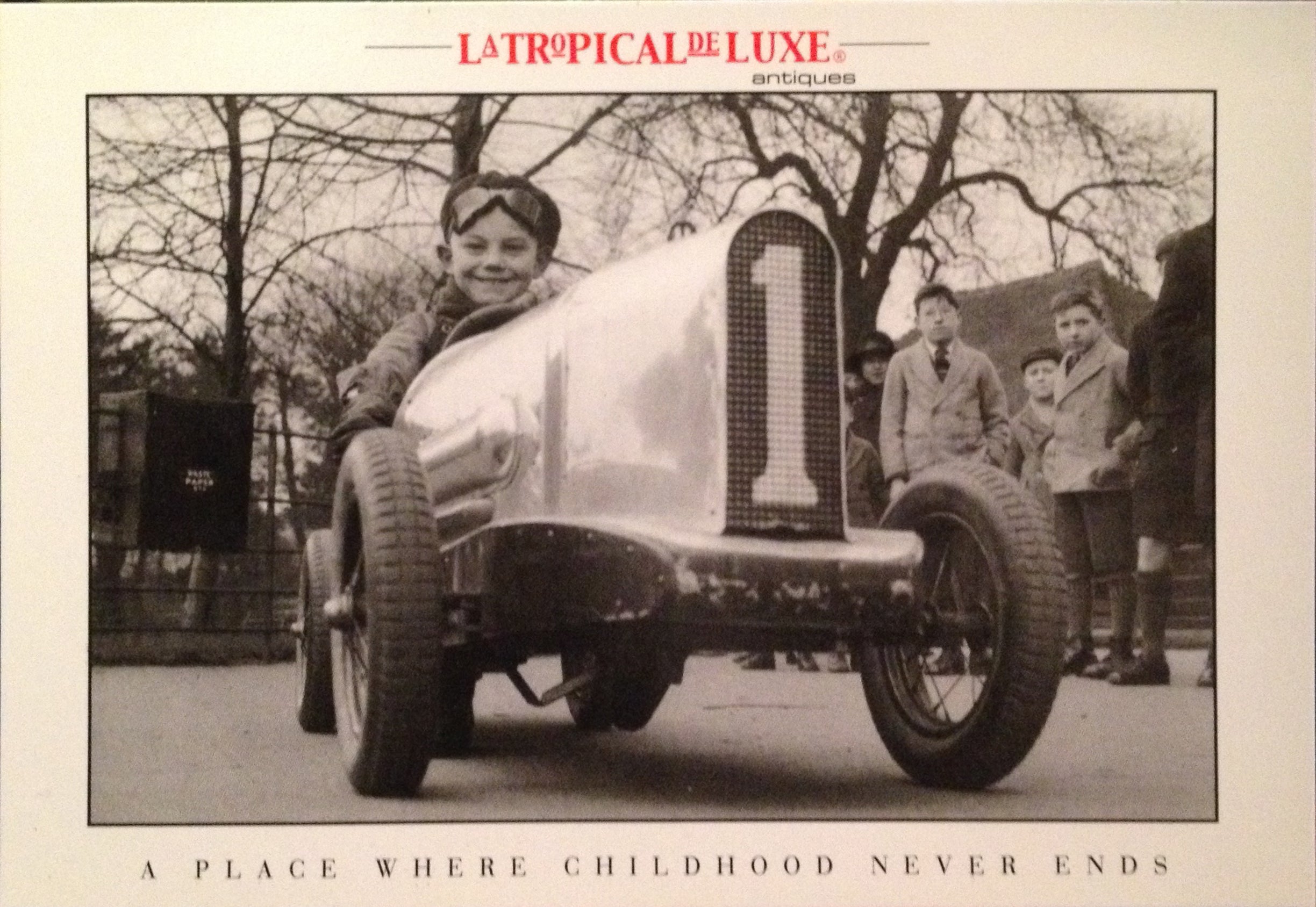
About the Seller
4.9
Vetted Professional Seller
Every seller passes strict standards for authenticity and reliability
Established in 2002
1stDibs seller since 2016
322 sales on 1stDibs
Typical response time: 1 hour
- ShippingRetrieving quote...Shipping from: Buenos Aires, Argentina
- Return Policy
Authenticity Guarantee
In the unlikely event there’s an issue with an item’s authenticity, contact us within 1 year for a full refund. DetailsMoney-Back Guarantee
If your item is not as described, is damaged in transit, or does not arrive, contact us within 7 days for a full refund. Details24-Hour Cancellation
You have a 24-hour grace period in which to reconsider your purchase, with no questions asked.Vetted Professional Sellers
Our world-class sellers must adhere to strict standards for service and quality, maintaining the integrity of our listings.Price-Match Guarantee
If you find that a seller listed the same item for a lower price elsewhere, we’ll match it.Trusted Global Delivery
Our best-in-class carrier network provides specialized shipping options worldwide, including custom delivery.More From This Seller
View AllArt Deco Grisby Bear Sculpture Bronze Bookends, France, circa 1925
By Ch. Soudant
Located in Buenos Aires, Olivos
Art Deco Grisby bear bronze bookends, France, circa 1925.
Mounted over brown marble base. signed Ch. Soudant, and foundry marks Susse freress ed. Paris. Very Nice sculpture of a play...
Category
Early 20th Century French Art Deco Animal Sculptures
Materials
Bronze
Art Deco Pair of Silvered Metal Playing Bears Bookends, France, 1920's
By Émile Nestor Joseph Carlier 1
Located in Buenos Aires, Olivos
Emile Joseph Nestor Carlier (French, 1849-1927) Art Deco Pair of Silvered Metal Playing Bears Bookends. Each with impressed “FABRICATION FRANCAIS PARIS” foundry mark. Made in France,...
Category
Early 20th Century French Art Deco Animal Sculptures
Materials
Marble, Metal
Art Deco Bronze Figure of a Cat 'Chat De Siam Assis' by Edouard M. Sandoz
By Susse Freres, Edouard-Marcel Sandoz
Located in Buenos Aires, Olivos
Very Rare Art Deco French silver plated bronze sculpture figure of a cat, ' Chat De Siam Assis ‘. This figure was produced as paperweight and also as car ...
Category
Early 20th Century French Art Deco Animal Sculptures
Materials
Bronze
Big Silvered Bronze Vienna Dog Sculpture, Paperweight, 1900s
Located in Buenos Aires, Olivos
Big silvered bronze Vienna dog sculpture, 1900s. Very good detailed silvered bronze dog sculpture. Perfect as desk paperweight.
We have specialized in the ...
Category
Early 20th Century Austrian Art Nouveau Animal Sculptures
Materials
Bronze
Austrian Bronze Bear Cigar Cutter, ca 1900´s
Located in Buenos Aires, Olivos
A solid bronze bear sculpture desktop cigar cutter manufactured in Austria. The scissor action steel blades are remove-able form the mouth of the roaring bear. Excellent condition. S...
Category
Early 20th Century Austrian Art Deco Tobacco Accessories
Materials
Bronze
$2,399 Sale Price
20% Off
Art Deco Cat Sculpture Paperweight Silvered Bronze. Signed Rochard, France 1920
By Irénée Rochard
Located in Buenos Aires, Olivos
Art Deco Cat Sculpture / Figure Silvered Bronze. Signed Irénée Rochard. Made in France 1920´s. Lovely desk paperweight of a sitting cat playing,...
Category
Early 20th Century French Art Deco Animal Sculptures
Materials
Marble, Bronze
You May Also Like
French Antique Bronze Sculpture of She-Bear, Early XX Century
Located in New York, NY
This exquisite French animalistic bronze sculpture from the early twentieth century is beautiful in every way - its artistic expressiveness, as well as the highest-level rendition, h...
Category
Early 20th Century French Art Nouveau Animal Sculptures
Materials
Bronze
Viennese Bronze Figure of a Bear, Stamped Austria
Located in New York, NY
Viennese bronze figure of a bear, stamped Austria. Beautifully hand painted with realistic multi-tone brown fur, open mouth, and black eyes.
Vienna, circa 1900.
Category
Antique Early 1900s Austrian Animal Sculptures
Materials
Bronze
A Solid Cast Bronze Japanese Figure of Bear, Early 20th Century
Located in ARMADALE, VIC
A Solid Cast Bronze Japanese Figure of Bear, Early 20th Century
Dimension: Height: 15cm Width: 26cm Depth: 11.5cm
Provenance: Private Melbourne Collection.
Category
Early 20th Century Japanese Sculptures and Carvings
Materials
Bronze
$475 Sale Price
50% Off
Vintage Large Etched Solid Brass Bear Animal Figurine
Located in Portsmouth, VA
This is an absolutely beautiful brass bear statue, depicting a confident bear standing proudly on a rocky hill. With its intricate etched detailing, this piece captures the bear's st...
Category
Mid-20th Century Indian Animal Sculptures
Materials
Brass
Late 19th Century Sculpture of a Sitting Bear - Black Forest Bronze
Located in Casteren, Noord-Brabant
Charming 19th-century bronze sculpture of a seated bear, captured in a lively, upright pose. The artist has rendered the animal’s fur with expressive surface texture and stylized det...
Category
Antique 1880s French Black Forest Animal Sculptures
Materials
Marble, Bronze
Bronze glazed ceramic bear statue, Spain 1940s
By Santa Monica
Located in ECHT, NL
Statue of two bears playing. It is made from ceramic with a copper colored glazing. Made in the 1960s in Spain by Santa Monica pottery. Marked underneath but...
Category
Mid-20th Century Spanish Art Deco Animal Sculptures
Materials
Ceramic
$951 Sale Price
20% Off
More Ways To Browse
New England Antiques
German Antique Ornaments
Vintage Childrens Car
Hood Chair
Car Hood Ornaments
Lalique Hood Mascot
Antique Car Ornaments
Car Mascot Hood Ornament
Lalique Bear
Car Bronze Sculpture
Art Deco Hood Ornament
Vintage Penguin
Wolf Bronze
Wood Carousel Horse
Art Deco Rabbit
Bronze Fox
Carousel Horse Sculptures
Carved Wood Animal Heads
